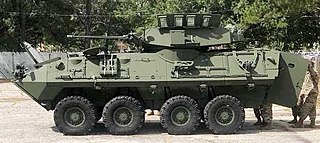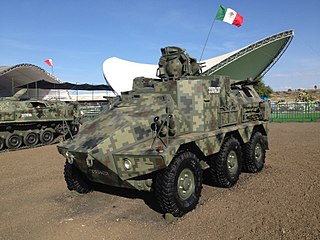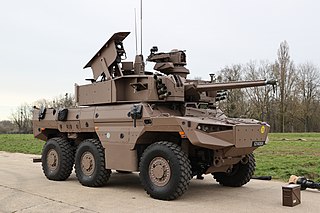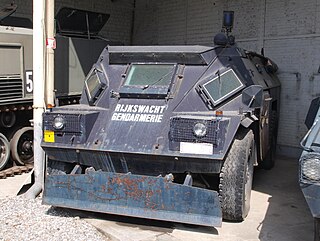
A military armoredcar is a lightweight wheeled armored fighting vehicle, historically employed for reconnaissance, internal security, armed escort, and other subordinate battlefield tasks. With the gradual decline of mounted cavalry, armored cars were developed for carrying out duties used to be assigned to light cavalry. Following the invention of the tank, the armored car remained popular due to its faster speed, comparatively simplified maintenance and low production cost. It also found favor with several colonial armies as a cheaper weapon for use in underdeveloped regions. During World War II, most armored cars were engineered for reconnaissance and passive observation, while others were devoted to communications tasks. Some equipped with heavier armament could even substitute for tracked combat vehicles in favorable conditions—such as pursuit or flanking maneuvers during the North African Campaign.

The M8 light armored car is a 6×6 armored car produced by the Ford Motor Company during World War II. It was used from 1943 by United States and British forces in Europe and the Pacific until the end of the war. The vehicle was widely exported and as of 2006 still remained in service with some countries.

The M3 Scout Car was an American-produced armored car. The original M3 Scout Car was produced in limited numbers, while the improved M3A1 Scout Car saw wide service during World War II and after.

The LAV-25 is a member of the LAV II family. It is an eight-wheeled amphibious armored reconnaissance vehicle built by General Dynamics Land Systems and used by the United States Marine Corps and the United States Army.

The Cadillac Gage Commando, frequently denoted as the M706 in U.S. military service, is an American armored car designed to be amphibious. It was engineered by Cadillac Gage specifically for the United States Military Police Corps during the Vietnam War as an armed convoy escort vehicle. The Commando was one of the first vehicles to combine the traditionally separate roles of an armored personnel carrier and a conventional armored car, much like the Soviet BTR-40. Its notable height, amphibious capability, and waterproofed engine allowed American crews to fight effectively in the jungles of Vietnam by observing their opponents over thick vegetation and fording the country's deep rivers.

The Pandur is an APC developed and produced by the Austrian company Steyr-Daimler-Puch Spezialfahrzeuge (SSF). It was developed during the 1980s as a private venture. In 2003, General Dynamics took over Steyr-Daimler-Puch which is now part of General Dynamics European Land Systems, which is also the parent company of MOWAG, Santa Bárbara Sistemas and GD ELS – Germany.

The Gendarmerie (French) or Rijkswacht (Dutch) was the former paramilitary police force of Belgium. It became a civilian police organisation in 1992, a status it retained until 1 January 2001, when it was, together with the other existing police forces in Belgium, abolished and replaced by the Federal Police and the Local Police.

The AIFV is a US tracked light armored vehicle that serves as an infantry fighting vehicle (IFV) in the armies of several countries. It is a development of the M113A1 armored personnel carrier.

The Dragoon 300 AFV was produced by Arrowpointe Corporation during the 1980s. It was based on the automotive components of the United States Army's M113 APCs and 5-ton trucks. It resembles a larger V-150 Commando.

Before 2001, there were several police forces in Belgium:

Timoney Technology Limited of Ireland is an Irish company which designs, develops and manufactures powertrains and independent suspension systems for heavy duty trucks, motor coaches and military vehicles. Timoney designs and develops a variety of standard armoured and soft skin mobility systems for military, commercial and specialist applications, principally utilising an independent suspension technology.
BDX could mean any of the following:

The Fahd is a 4x4 Egyptian armored personnel carrier, designed to fit the requirements of the Egyptian Military. It replaced older APCs in Egyptian service such as the BTR-40, and the Walid. It has been used by the United Nations.
Akrep ("Scorpion") is a Turkish infantry mobility vehicle developed by Otokar Otobus Karoseri Sanayi AS. The first prototypes were completed in May 1993 and the first vehicles came off the production line in June 1994. In addition to light reconnaissance, the vehicles were used for escort, perimeter control, counter-insurgency, and light attack. The Akrep represented the latest offering in Otokar's portfolio of light vehicles for both civilian and military markets. Note that otokar comes from French autocar and designs busses that also can transport luggage. Passengers being at the higher level.

The Panhard VCR is a light armored personnel carrier (APC) designed by Panhard for the export market and later used by several countries. After Iraq ordered French turrets in September 1974 capable of launching antitank guided missiles (ATGM), the Panhard VCR was developed at the request of the Iraqis for vehicles with which to mate these ATGM-launcher turrets. This resulted in the largest order of VCRs, 100, for Iraq.

The Nurol Ejder is a family of armoured vehicles produced by Turkish company Nurol Makina. Two versions exists under the Ejder name, a 6x6 version, and a more popular 4x4 version, called Ejder Yalcin.

The Type 08 is a family of eight-wheeled amphibious, modular armored vehicle developed by Norinco for infantry fire support, battlefield logistics and quick reaction operations. It is a recent People's Republic of China produced Infantry fighting vehicle for People's Liberation Army Ground Force and People's Liberation Army Marine Corps.

The Engin Blindé de Reconnaissance et de Combat Jaguar or EBRC Jaguar is a French armoured reconnaissance vehicle that will replace the French Army's AMX 10 RC and ERC 90 Sagaie reconnaissance and fire support vehicles as well as the VAB Mephisto.
The 1st Light Regiment (1LR), was a voluntary Gendarmerie regiment of the Belgian Army that served in the Battle of Belgium and in the German Occupation of Belgium.

The Timoney armoured personnel carrier refers to a series of armored personnel carriers developed by Timoney Technology Limited of Ireland in the 1970s and 1980s.
This page is based on this
Wikipedia article Text is available under the
CC BY-SA 4.0 license; additional terms may apply.
Images, videos and audio are available under their respective licenses.
















